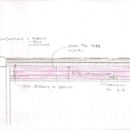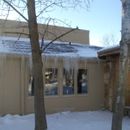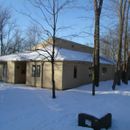Foam sheets on underside of this ceiling to stop ice dams?
One room on the east side of the building has a cathedral ceiling with NO insulation. The ceiling is made from 2×6 T&G spanning 8 Ft on center, with the ends supported by walls and the center by a truss. The other rooms have an attic.
We would like to add insulation to the underside of the cathedral ceiling and are considering:
a) Two layers of 2”polyiso
b) Two layers of ¾ polyiso
c) 1×6 carsiding
(1) Do I nail the first layer to the ceiling or then to each other to hold in place?
(2) Should I use canned foam (what type) to seal the edges?
(3) Should I tape the seams on each layer or just the final layer(metal faced tape)?
(4) How should the carsiding will be mounted under the foam
1×4 screwed to the ceiling through the foam or
2×6 24 on center and along the walls ( creates a thermal bridge but gives a way to mount lights)
(5) how can I mount lights and fans?
Any help would be appreciated
this building is a nature center in SE WI.
and are faced with high energy costs and ice dams.
GBA Detail Library
A collection of one thousand construction details organized by climate and house part













Replies
You can't use stacked up polyiso against the roof deck, since it would block the drying of the roof deck toward the interior.
You CAN use unfaced EPS though. At 5.5" Type-II EPS (1.5lbs nominal density) it would run about 0.54 perms,a class-II vapor retarder, but as vapor open as a kraft facer, which would be sufficient for protecting the roof deck from excessive wintertime moisture accumulation, yet provide a path for seasonal drying during warmer weather. Type-II EPS runs R4.2/inch @ 75F center foam temp, R4.5/inch @ 40F center-foam temp, so at the outdoor temperatures that matter the most from a moisture accumulation point of view you'd get at least R25 out of it. When the roof deck is 30-32F (the temps most relevant from an ice-damming point of view) and the ceiling is 70F the center foam temp would run about 50F, making the foam about R24, which is enough to make a HUGE difference.
When it's time to re-roof, add another 6" of EPS on the top of the roof deck and you'll never see ice dams again.
At the edges and where the foam meets the trusses foam leave a 1/4" gap around it, and use foam board construction adhesive to tack it in place (you may need to temporarily use nails, but pull them), tape the butted seams of the EPS with housewrap tape, an d use a FrothPak kit to fill in the gaps and air seal the 1/4" gaps at the edges. It's possible to do it with can-foam, but it can take a lot of cans. A 12 board-foot FrothPak is something like $40 at box stores, and a better bang/buck than cans when you have a lot of sealing to do.
To hold it permanently, through-screw 1x4 or 2x4 furring 24" o.c. with pancake head timber screws, sized to bite at least an inch into the 2x t & decking, and ring-shank-nail or screw the carsiding to the furring. Avoid recessed can lighting like the plague, since that would produce hot-spots in the roof deck to start the whole ice-damming process. Use surface mount high-efficiency (fluorescent or LED) fixtures only. Mount the fans directly at a furring strip, and add a second timber screw for mechanical security.
[Note to GBA readers: "Car siding" is a regional term; in some areas of the U.S., it means tongue-and-groove boards.]
Walt,
First of all, your plan will only work if you can find a way to air seal the perimeter of your ceiling. If air is leaking from your stud bays into your rafter bays, which is possible, these air leaks will short circuit your intended fix. It might be a good idea to install dense-packed cellulose in your stud bays (even if the walls already have fiberglass batts).
Q. "Do I nail the first layer to the ceiling?"
A. Yes, Just use the minimum number of nails to hold each layer of rigid foam in place. You probably want to use cap nails (supplemented with a foam compatible adhesive if you want). Successive layers of rigid foam will need to be attached with longer cap nails or screws with washers.
Q. "Should I use canned foam (what type) to seal the edges?"
A. You can use canned spray foam, caulk, or high-quality tape, depending on your preference and the width of the gap.
Q. "Should I tape the seams on each layer or just the final layer (metal faced tape)?"
A. That's up to you. Taping at least two layers will provide you with a belt-and-suspenders air seal.
Q. "How should the car siding will be mounted under the foam?"
A. You should attach 1x4 or 2x4 furring (16 inches on center or 24 inches on center) on the underside of the final layer of rigid foam. The furring is attached to the rafters or the old ceiling with long screws. Then you can fasten your new ceiling boards to the furring strips.
Q. "How can I mount lights and fans?"
A. You can either use surface-mounted metal boxes and conduit, or you can create a service chase with 2x4 framing between your ceiling boards and the rigid foam. For more information on service cavities, see Service Cavities for Wiring and Plumbing.
I hope I have explained this construction properly There are no rafter bays above the ceiling I want to insulate. The ceiling is 2x6 T&G laid flat spanning from one wall to another 16 apart with one open truss in the center of the room.
I could seal the ends of the 2x6 ceiling with spray foam if necessary
I have attached another file please look it over
Wouldn't it be better to insulate with rigid foam above the roof deck. This would keep the the nice T&G visible from the inside. I would imagine the ice has taken a toll on the shingles and possible the roof deck.
Unfortunately a new roof was put on last summer.
these reply's are confusing, should I use EPS or polyiso?
Can you open that dwg file,, it's from a very old program
Walt,
I'm sorry for the confusion about the rafter bays; that was my fault. I hadn't studied the drawings and photos carefully enough.
I disagree with Dana. It isn't necessary for the roof sheathing to dry inward. It's fairly common to build a roof that has roof sheathing that can't dry to the interior (for example, when closed-cell spray foam is installed on the underside of the roof sheathing).
As long as the roof sheathing is dry on the day when you install your rigid foam, everything should be fine. There's no reason you can't install polyiso.
It absolutely IS necessary for the roof to have a drying path. Even 6" of closed cell foam is semi-permeable at about 0.2 perms, whereas foil facers are not. That 0.2 perms isn't a high rate drying path, but it's about half that of a kraft facer, but 200x that of six foil facers. (Three layers of foil-faced iso.) That's the difference between a tight class-II vapor retarder and a true vapor barrier.
Over the course of the winter with a snow load even #30 felt becomes saturated. The permeance of the combined stackup of shingles + felt is only about 0.1 perms- half that of 6" of closed cell foam. ANY moisture that gets into the roof deck stays there if the interior side is 0.001 perms (about when you get when you stack 6 layers of foil.) There WILL be moisture penetration over time under repeated snow loading, but it's of no consequence if you have a drying path drying path on the interior 5x more permeable than the felt + shingles.
I guess we'll just have to keep disagreeing on this one, eh? :-)
Dana,
Indeed, we'll have to agree to disagree.
If you think that a layer with a permeance of 0.2 perm will make the difference between success and failure -- due to drying through the 0.2-perm layer -- let's just say I'm a skeptic. The reason that these roofs stay dry is not because they dry inward through 02.-perm foam; it's because they don't get wet.
You seem to think that roof sheathing can get wet through asphalt shingles and asphalt felt underlayment. This topic has been debated for over a decade, and there have been many comments on the topic posted recently on a different blog page (Open-Cell Spray Foam and Damp Roof Sheathing). The usual mechanism proposed for this phenomenon is inward solar vapor drive. You are proposing that snow is the cause.
Joe Lstiburek says, however, that moisture doesn't come through asphalt shingles and felt underlayment and cause sheathing to get damp. He says that when roof sheathing gets damp, the moisture comes from the interior.
Whichever foam I use, attaching the lights and fans is a problem. At present the thin-wall conduit for the lights is in the roof decking. There is nothing behind the box but tar paper.
I read the service cavity article referenced. But don't see a solution there.
If I run 2x6 between the foam sheets( creating "rafter bays") I loose insulation and create a thermal bridge. But if I screw 1x4 to the ceiling through 5.5 inches of foam can I mount a light or fan box to the 1x4 and meet code?
Opps
Sorry
Walt,
If you want a service cavity on the interior side of the rigid foam, use 2x4 strapping. (I'll admit that you need to choose your screw length carefully, because you have to screw through the rigid foam to the 2-by roof sheathing, without puncturing the roofing.)
That gives you a 1.5-inch-deep wiring chase. If you prefer a 3-inch-deep wiring chase, install a second layer of 2x4 strapping, perpendicular to the first layer.
The difference between 0.2 perms and 0.001 perms is the difference between "can release the moisture of a roofing-nail leak within a summer" and " releases moisture never".
Of course it's better to start with dry wood in the first place.
I'm proposing that nothing gets out under a snow, load, only in, and when heated by the sun some of the moisture in the felt can end up in the sheathing, but very little gets back through the ~0.1 perm shingle/felt stackup.
Yes, it will always be true that moisture drives from the interior is the primary cause of damp roof decking. But on a good/better/best practices point of view giving the wood a drying path is better than no path. A half-perm stack of EPS is a pretty good drying path- way better than 0.2 perm closed cell polyurethane or 0.1 perm asphalt/felt. Foil facers are orders of magnitude below that, and you're counting on the roof never having even the slightest seepage (as if ice dams can never back up under a mere R30-ish stackup of iso.)